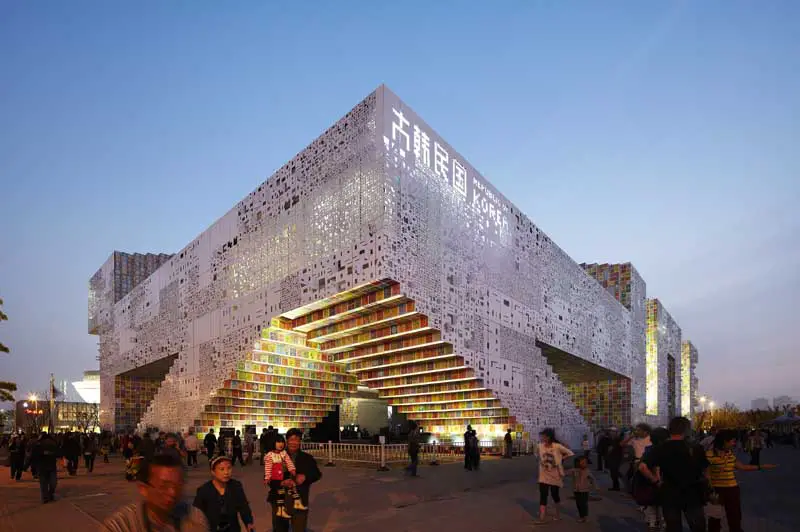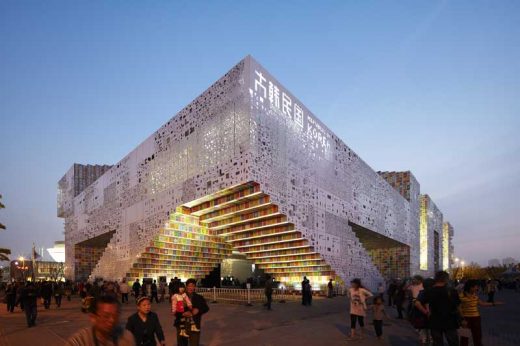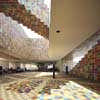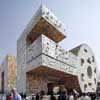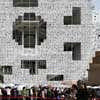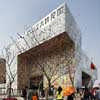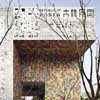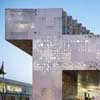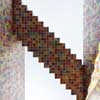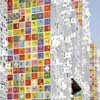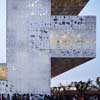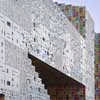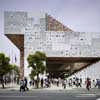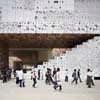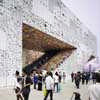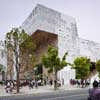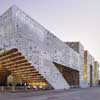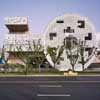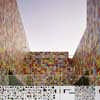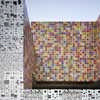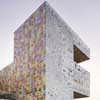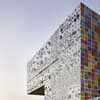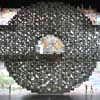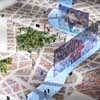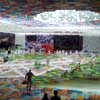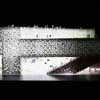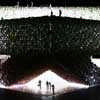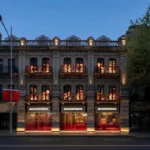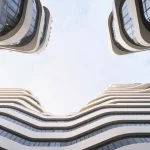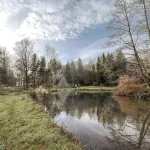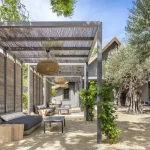Shanghai Expo 2010 Korean Pavilion, Images, Mass Studies Architects, Chinese Design
Shanghai Expo Korean Pavilion
Architecture Information China – design by Mass Studies
17 May 2010
Korea Pavilion Shanghai Expo
New Photos of the Shanghai Korean Pavilion
Further new images from 17 May inserted in article below
11 May 2010
Korean Pavilion at Shanghai Expo 2010
Context
The World Expo 2010, held in Shanghai, China, is expected to be the largest world expo to date. The theme of the exposition will be “Better City, Better Life,” and the event is to take place from May 1 until October 31, 2010, with more than 192 participating countries to accommodate the 70 million expected visitors.
Site
The Korea Pavilion is situated in Zone A, directly neighboring the Japan Pavilion and the Saudi Arabia Pavilion, and in close proximity to the China Pavilion. The site is around 6000m2, and it is one of the largest lots within the Expo compound. Located on the perimeter of the zone, the site takes advantage of the views out towards the Huangpu River and the Shanghai skyline in the distance.
Concept
With land culture (China) and sea culture (Japan) surrounding the peninsula, Korea has been permeable to imported cultures and global influences, whose progressive mix defines contemporary Korean society. Using ‘convergence’ as the main theme, the Korea Pavilion is an amalgamation of ‘sign’ (symbol) and ‘space’: Signs become spaces, and simultaneously, spaces become signs.
Sign as Space
Han-geul, the Korean alphabet, is the prime element of ‘signs’ within the pavilion. The overall volume, lifted 7.2m above ground level, is created by converging these Han-geul letters, allowing signs to create the exhibition space, and so that the visitors can experience their geometry through horizontal, vertical and diagonal movements. The primary geometries that compose the Han-geul letters are universal to other cultures, thus acting as a sort of ‘open’ set of signs that is engaging to everyone.
The exterior surfaces of the Korea Pavilion are clad in 2 types of pixels: Han-geul Pixels and Art Pixels. Han-geul Pixels are white panels with a relief of letters in four different sizes whose combination forms the majority of the exterior, mainly the peripheral surfaces. Most of the non-peripheral surfaces are composed of Art Pixels, which are 45cm x 45cm aluminum panels created by a Korean artist, Ik-Joong Kang, who is renowned for creating massive art walls out of small hand-painted tiles, either self-produced or by gathering from around the world (thus being another type of convergence). About 40,000 of these panels will texture the façade, contributing a bright palette of colors, hope, and unity throughout the Korea Pavilion.
The art pixels, individually autographed by the artist, will be sold at the end of the Expo. All sales proceeds will be donated to an international charity organization. Not only will it raise funds for a cause, but through this social and artistic process, the recycling of façade material units, as works of art, will also enhance the sustainability of the Korea pavilion in a unique way, by directly and critically addressing the sustainability of this temporary structure that is only 6-months in use. The surfaces will project different atmospheres during the day and night, with light and shadows creating different textures. Sequential lighting is installed behind the Hangeul Pixels to highlight the individual letters on the exterior façade at night, further animating the pavilion as a sign (like a text message) on a larger scale.
Space as Sign
By understanding a map to be a type of a sign that depicts space, we’ve translated the ground level piloti space as a sign, by making an abstract 1/300 scale 3D map of a characteristic Korean city as its surface. The rest of the building, containing the exhibition space, is suspended 7m above to create a 40m x 77m free, open space generated by the map. The map becomes a semi-exterior landscape that expresses the converging of mountains, water, and a dense metropolitan area, as exemplified by Seoul, the national capital. This ground floor is shaded by the main volume and additionally cooled by the a replica of a river (modeled after the Han River) flowing from one corner to the other as a 5m wide, 79m long artificial stream, while the notable mountains become stages/seating/spaces for the visitors to enjoy shows while queued in line to enter the exhibition space above, to improve the typical inverted condition that most visitors spend more time waiting than experiencing the exhibition itself. There is also a series of LFD monitors, a large LFD screen and two water screen projections to assist the interaction with the visitors.
Program
Upon entering the second level of the pavilion, the floor opens up to a gigantic 3,700m2 exhibition space, that is enclosed in complete darkness, to provide a controlled environment for the exhibition. We take advantage of the space by opening it up as an open flat plane, to be able to handle an extremely heavy load of visitor traffic. The level above contains the VIP Lounge, Press Room, Conference Room, and programs for the staff and administration.
On the opposite end of the exhibition space (at the north-western side of the building) is a restaurant with its own self-operating circulation, and an access to a roof garden that overlooks the Huangpu River and Shanghai’s skyline.
Shanghai Expo 2010: Korea Pavilion – Building Information
Design Period: Sep 2008 – May 2009
Construction Period: Jun 2009 – Apr 2010
Type: Pavilion (Competition)
Location: Shanghai, China
Site Area: 6,000 sqm
Total Floor Area: 7,683.5 sqm (incl. 50% piloti area)
Building Scope: 3F
Structure: SC
Finish: Composite Aluminum Panels, EPDM Blocks
Architects: Mass Studies
Minsuk Cho, Kisu Park, Joungwon Lee, Taehoon Hwang, Hyunseok Jung, Joonhee Lee, Hyunjung Kim, Bumhyun Chun, Jisoo Kim, Moonhee Han, Sungpil Won, Kyungmin Kwon, Dongwon Yoon, Betty Bora Kim, Kyehnyong Kwak, Jungwook Lee
Construction Drawings: NIKKO
Structural Engineer: SD: Ove Arup & Partners ; CD: NIKKO
MEP Engineer: NIKKO
Facade Consultant: Axis Facades
Interior (Exhibition): Cheil Worldwide
Multimedia: SigongTech
Client: Korea Trade-Investment Promotion Agency
Shanghai Expo Korean Pavilion images / information from Mass Studies
Location: Shanghai, China
Architecture in Shanghai
Shanghai Architecture Designs – chronological list
Shanghai Architecture Walking Tours
Shanghai Building – Expo Pavilion Selection
Danish Pavilion, Expo 2010
BIG
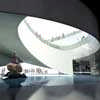
image from architects
Shanghai Expo 2010 Danish Pavilion
Architecture Walking Tours by e-architect
British Pavilion Shanghai Expo 2010
Heatherwick Studio
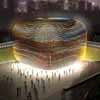
image from architects
Shanghai Expo British Pavilion
Spanish Pavilion Shanghai Expo 2010
Miralles Tagliabue EMBT
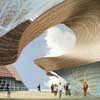
image from architects
Shanghai Expo 2010 Spanish Pavilion
RÉN building, Expo 2010
BIG
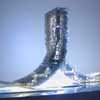
image from architects
Shanghai Expo 2010 Building
Comments / photos for the Shanghai Expo Korean Pavilion 2010 Architecture page welcome
Shanghai Expo Korean Pavilion
Design – page
